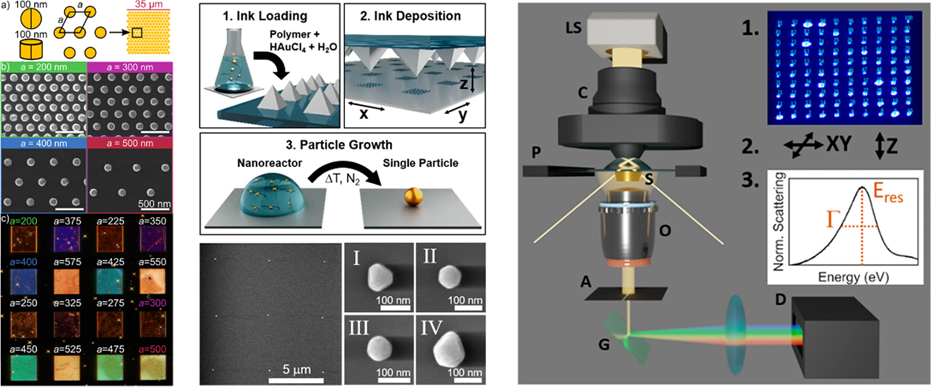
Coupling among localized surface plasmons can induce changes in their shape and energy as well as the emergence of new resonances. In addition to such near-field coupling and plasmon mode hybridization, intriguing phenomena emerge when plasmons couple within nanoparticle arrays. Plasmonic resonators, such as metal nanoparticles, when arranged periodically, exhibit diffractive characteristics defined by their spatial arrangements. As the array dimensions become comparable to the wavelength of incident light, lattice plasmons, also known as surface lattice resonances, appear with remarkably narrowed spectral linewidths down to several nanometers. Such far-field coupled resonances minimize non-radiative energy loss, while maximize the quality factor of the nanophotonic system. Conventional lithography enables the precise fabrication of patterned micro-nanostructures.
While we have exploited electron-beam lithography to create plasmonic RGB pixels from arrays of aluminum nanorods, our current interests extend to studies on the optical properties of plasmonic arrays prepared through a combined top-down printing and bottom-up colloidal growth approach: polymer-pen lithography. By engineering nanostructures and patterning their arrays, we conduct high-throughput analysis of collective optical properties to identify enhanced absorptive and radiative as well as thermal features.
Selected publications:
- N. Gross, W. Wang, S. Brasel, E. K. Searles, B. Bourgeois, J. A. Dionne, C. F. Landes, and S. Link, High-Throughput Screening of Optical Properties of Glass-Supported Plasmonic Nanoparticles Fabricated by Polymer Pen Lithography, J. Phys. Chem. C, 127, 39, 19607–19619 (2023)
- T. S. Heiderscheit, S. Oikawa, S. Sanders, H. Minamimoto, E. K. Searles, C. F. Landes, K. Murakoshi, A. Manjavacas, and S. Link, Tuning Electrogenerated Chemiluminescence Intensity Enhancement Using Hexagonal Lattice Arrays of Gold Nanodisks, J. Phys. Chem. Lett., 12 (10), 2516 (2021)
- J. Olson, A. Manjavacas, T. Basu, D. Huang, A. E. Schlather, B. Zheng, N. J. Halas, P. Nordlander, and S. Link, High Chromaticity Aluminum Plasmonic Pixels for Active Liquid Crystal Displays, ACS Nano, 10(1), 1108 (2016)
- J. Olson, A. Manjavacas, L. Liu, W.-S. Chang, B. Foerster, N. S. King, M. W. Knight, P. Nordlander, N. J. Halas, and S. Link, Vivid, Full-color Aluminum Plasmonic Pixels, Proc. Natl. Acad. Sci., 11, 14348 (2014)